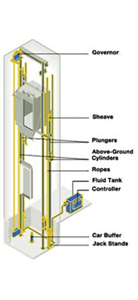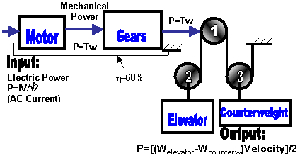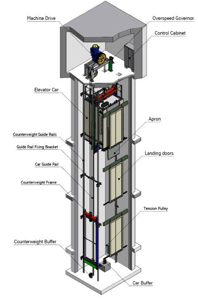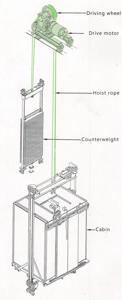




A traction elevator is a type of elevator that operates using a system of ropes and pulleys powered by an electric motor. The key mechanism involves the motor turning a sheave (a grooved pulley), around which strong steel ropes are looped. One end of the ropes is attached to the elevator car, and the other to a counterweight.
Working Principle:
-
When the motor turns the sheave, it causes the ropes to move, which in turn lifts or lowers the elevator car.
-
The counterweight balances the weight of the elevator car, reducing the power required by the motor to move the elevator up or down.
-
As the elevator car ascends, the counterweight descends and vice versa, making the system energy-efficient by minimizing strain on the motor.
-
The motor can move in both directions, enabling the elevator car to go up and down smoothly.
Main Components:
-
Cables or Ropes: Typically multi-strand steel for safety and strength.
-
Sheave: The toothed pulley driving the ropes, powered by the motor.
-
Counterweight: Provides balance to the elevator car to conserve energy.
-
Motor: Powers the sheave and controls the elevator's movement.
-
Machine Room: Usually houses the motor and control systems (though some traction elevators are machine-room-less).
-
Safety Devices: Including overspeed governors and brakes to ensure safe operation.
Advantages:
-
Smooth, quiet operation.
-
Energy-efficient due to counterweight balancing.
-
Suitable for both low-rise and high-rise buildings.
-
Can achieve high speeds, especially in gearless designs, making them ideal for tall buildings or heavy usage.
-
High weight capacity, capable of carrying large groups or heavy loads safely.
In summary, traction elevators use a balanced, rope-and-pulley mechanism powered by a motor and counterweight to provide efficient, safe, and smooth vertical transportation, making them the preferred choice for many commercial and residential buildings.
- https://dazenelevator.com/traction-elevator-everything-you-need-to-know/
- https://gartec.com/blog/how-do-traction-lifts-work/
- https://www.libertyelevator.com/blog/what-is-a-traction-elevator/
- https://www.fujisj.com/news/the-working-principle-and-structure-of-traction-elevator/
- https://www.houseofelevators.com/what-is-the-structure-and-working-principle-of-a-traction-elevator/
- https://masind.net/blog/the-ultimate-guide-to-elevator-traction-machines/
- https://www.northernelevator.co.uk/what-is-a-traction-lift/
- https://swiftlifts.com/hi/how-does-an-elevator-work/
- https://www.youtube.com/watch?v=rKp4pe92ljg
- https://cibeslift.in/traction-vs-hydraulic-vs-screw-driven-lifts/


